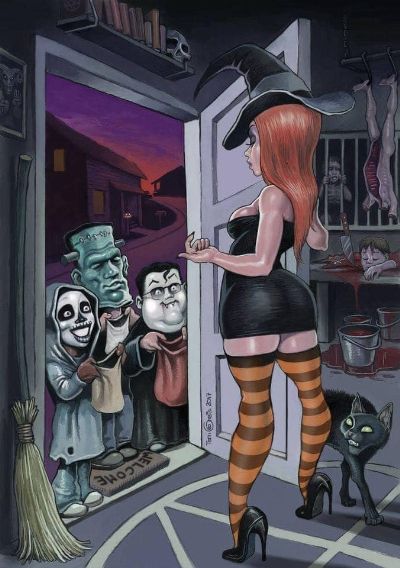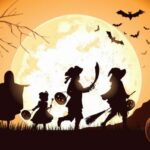The main event of modern US-style Halloween is trick-or-treating, in which children dress up in costume disguises and go door-to-door in their neighborhood, ringing each doorbell.

According to this custom, children greet each homeowner with the cry “Trick or Treat,” suggesting that some sort of prank will be played unless treats are provided.
Formerly, trick-or-treaters vandalized the house if no treats were produced or if the treats met with their disapproval. Since the early 20th century, however, the threat of tricks has been largely ceremonial.
The activity is prevalent in the United Kingdom, Ireland, the United States, Canada, and Australia.
In northwestern and central Mexico, this practice is called calaverita (Spanish diminutive for calavera, “skull” in English), and instead of “Trick or treat”, the children ask, “¿Me da mi calaverita?” (“Can you give me my little skull?”), where a calaverita is a small skull made of sugar or chocolate.
Origin
While some identify precursors to trick-or-treating in ancient Celtic customs, modern trick-or-treating is thought to be a custom borrowed from guising or mumming in England, Scotland, and Ireland. These involve dressing in costume and singing a rhyme, doing a card trick, or telling a story in exchange for a sweet.
Some have traced the earliest print reference of the term trick or treat to 1927 in Canada. It appears that the practice didn’t really take hold in the US until the 1930s, where it wasn’t always well received. The demanding of a treat angered or puzzled some adults. The Great Depression exacerbated the problem, with Halloween mischief often devolving into vandalism, physical assaults and sporadic acts of violence.
One theory suggests that excessive pranks on Halloween led to the widespread adoption of an organized, community-based trick-or-treating tradition in the 1930s. This trend was abruptly curtailed, however, with the outbreak of World War II, when sugar rationing meant there were few treats to hand out.
However, once the war finished, trick-or-treating reclaimed its place among other Halloween customs fueled by America sub-urbanization and national advertising campaigns launched by candy companies.
Ritual
The occupants of the house (who might themselves dress in a scary costume) will then hand out small candies, miniature chocolate bars, and sometimes even soda pop. Some American homes will use sound effects and fog machines to help set a spooky mood. Other house decoration themes (that are less scary) are used to entertain younger visitors. Children can often accumulate many treats on Halloween night, filling up entire pillow cases or shopping bags.
In Scotland, children or guisers are more likely to recite “The sky is blue, the grass is green, may we have our Halloween” instead of “trick or treat!”. They visit neighbors in groups and must impress the members of the houses they visit with a song, poem, trick, joke or dance in order to earn their treats. Traditionally, nuts, oranges, apples and dried fruit were offered, though sometimes children would also earn a small amount of cash, usually a sixpence. Very small children often take part, for whom the experience of performing can be more terrifying than the ghosts outside.
Trick or treat, you’re so neat.
Give me something good to eat.
Nuts and candy, fruit and gum.
I’ll go away if you give me some.Trick or treat, smell my feet.
I know you’ll give us lots of treats.
Not to big, not to small,
Maybe the size of Montreal.Trick or Treat, Trick or Treat,
Give me something nice to eat,
If you don’t we don’t care,
We’ll put money in your underwear
A child usually “grows out of” trick-or-treating by his or her teenage years. Trick-or-treating by teenagers is accepted, but generally discouraged with genial ribbing by those handing out candy. Teenagers and adults instead often celebrate Halloween with costume parties, staying home to give out candy, listening to Halloween music, watching horror movies or scaring people.
In 1982, a rash of poisoning deaths were tied to Tylenol pill bottles suspected of post-manufacturing tampering. The case was never solved, which inspired a wave of fear around trick-or-treating to the point where some towns in American banned it completely. Parents since have worried about razor blades, cyanide, and cannabis in Halloween candy—though most incidents of tampered candy are reported to be hoaxes.
A Trunk or Treat is a Halloween activity, usually hosted at a church or at another community location, where children gather candy from the opened trunks of cars parked in a large parking lot. Emerging in the 1990s, these events emerged as a safer alternative to trick-or-treating. Often the trunks are decorated with a theme, such as spooky, superheroes, Disney, or another childhood favorite theme, which has been nicknamed “Halloween tailgating.”
Charity balls are an elegant Halloween event in many regions of the United States. UNICEF introduced the Trick-or-Treat for UNICEF program in 1950 to promote their message of “children helping children” on a more local level (and provide a candy-free activity for children). Spirit Halloween stores initiated the Spirit of Children charity for children’s hospitals in 2006.
Alternate requests
- Spell or quell?
- Beast or feast?
- Caper or candy?
- Candy or bust?
- Scare or share?
- Gag or goodies?
- Deceit or treat?
- Smite or delight?
- Prank or thank?
- Sweet or defeat?
- Critique or treat?
- Fright or delight?
- Tragic or magic?
- Treat or I’ll tweet!
- Shenanigans or snacks?








